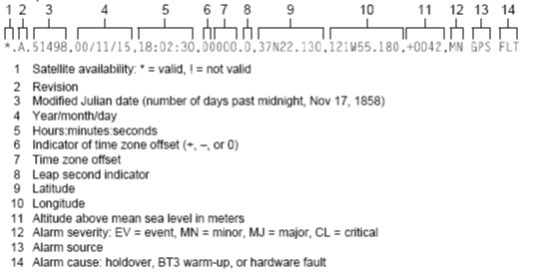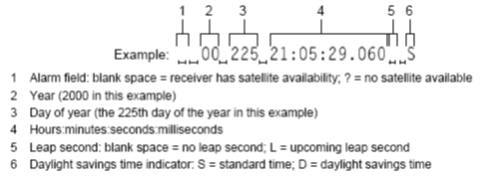Paragon-X: What Time of Day formats are supported, and what is their structure?
I see that Paragon-X allows the generation and capture of various ToD formats. What are these, and where can I find more information on the format of each?
Supported formats
Paragon-X is aware of the following formats:
- CCSA
- Cisco
- NTP
- NMEA (GPRMC and GPZDA)
- G.8271
References and details for each are given below.
CCSA
This format is based on an ITU-T contribution and forms the basis of the G.8271 ToD format discussed below. There are two message types: information and event.
CCSA information message fields
Field | Decode | Offset | Data type |
|---|---|---|---|
ToW (Time of Week) | GPS Second time of Week | 0 | U4 |
week | GPS week (GPS time) | 4 | I4 |
LeapS | Leap Seconds (Offset between GPS and UTC) | 8 | U2 |
PPS status | 0x00 = Normal 0x01 = Time synchronization node (Atomic clock) holdover 0x02 = Do Not Use 0x03 = Time synchronization node (stable oscillator) holdover 0x04 = transport node holdover all others reserved | 10 | I1 |
TAcc | PPS output jitter (0-255): 0–0ns 1-15ns 2-30ns … 255- no meaning note:the value should be set to 255 for transport and base station equipment | 12 | U1 |
CCSA Event message fields
Field | Decode | Offset | Data type |
|---|---|---|---|
Type of time source | 0x00 :BD(Compass) 0x01 :GPS 0x02 :1588 PTP 0x03 :others | 0 | U1 |
Status of time source | GPS fix Type, range 0..3 0x00 = no fix 0x01 = dead reckoning only 0x02 = 2D-fix 0x03 = 3D-fix 0x04 = GPS + dead reckoning combined 0x05 = Time only fix 0x06..0xff = reserved | 1 | U2 |
Monitor Alarm | Alarms of time source status: Bit 0: not used Bit 1: Antenna open Bit 2: Antenna shorted Bit 3: Not tracking satellites Bit 4: not used Bit 5: Survey-in progress Bit 6: no stored position Bit 7: Leap second pending Bit 8: In test mode Bit 9: Position is questionable Bit 10: not used Bit 11: Almanac not complete Bit 12: PPS was generated | 3 | U2 |
Cisco
Note that Paragon-X will recognise both period (.) and comma (,) as field delimiters.
NTP
NMEA
Paragon-X NMEA support is based on version 3.01 of the specification available to purchase here. Wikipedia has an overview of the format here.
An example of GPRMC message is $GPRMC,225446,A,4916.45,N,12311.12,W,000.5,054.7,191194,020.3,E*68, which decodes as
| Value | Meaning | Decoded |
|---|---|---|
225446 | Time of fix | 22:54:46 UTC |
| A | Navigation receiver warning | A = OK, V = warning |
| 4916.45,N | Latitude | 49 deg. 16.45 min North |
| 12311.12,W | Longitude | 123 deg. 11.12 min West |
| 000.5 | Speed over ground, Knots | 0.5 |
| 054.7 | Course Made Good, True | |
| 191194 | Date of fix | 19 November 1994 |
| 020.3,E | Magnetic variation | 20.3 deg East |
| *68 | Mandatory checksum |
An example GPZDA message is $GPZDA,172809.456,12,07,1996,00,00*45, which decodes as
| Value | Meaning | Decoded |
|---|---|---|
| 172809.456 | UTC | 17:28:09.456 UTC |
| 12 | Day of month | 12th |
| 07 | Month | July |
| 1996 | Year | 1996 |
| 00 | Local time zone offset from GMT, ranging from 00 through ±13 hours | 0 hours offset from GMT |
| 00 | Local time zone offset from GMT, ranging from 00 through 59 minutes | 0 minutes offset from GMT |
| *45 | Mandatory checksum |
G.8271
This is defined in Clause A.1.3 of the ITU-T G.8271 standard. These are serial messages sent once per second, at 9600 baud (default), no parity check, within 1ms of the 1PPS rising edge, with content that represents the time at which the current 1PPS starts, and which finish within 500ms.
The message structure is as shown below:
Detailed description of each of the three message types - event, announce and GNSS status - can be found in Clause A.1.3 of the G.8271 standard linked above.
Related articles



